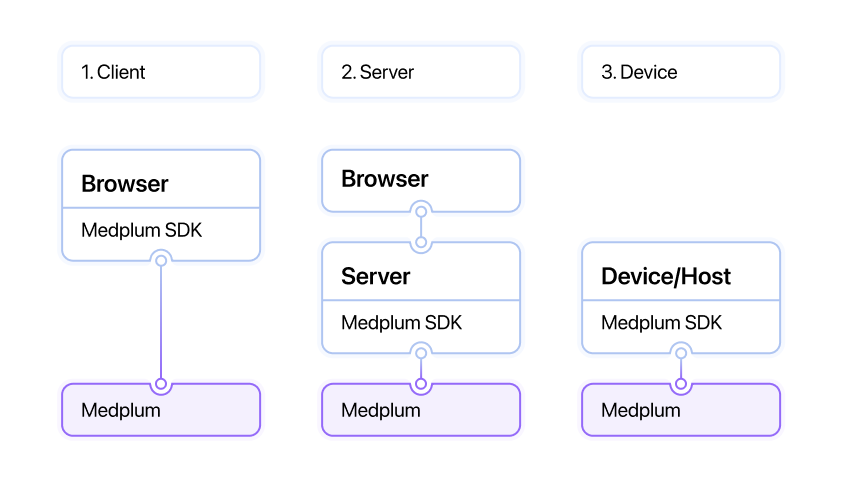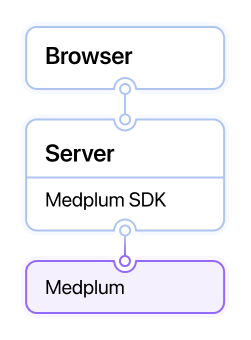Auth Integration Patterns
Medplum supports three primary authentication integration patterns, summarized by the following diagram. Each has its own use case. An implementation can use multiple or all patterns for different use cases.
This diagram shows a high level summary of the three common patterns. The Medplum Typescript SDK can (optionally) be used in all three patterns.

Client Side Authentication
Client side authentication is when a user facing application, usually running in a web browser connects directly to Medplum to request, create or update data. This integration pattern supports sophisticated configurations and has the best the response times. A summary is shown in the diagram below.
Client side authentication enables the following advanced features:
- Enable external identity providers, like Google, Okta and others
- Patient authentication
- IP Address restriction for logins
- Use of Medplum React components such as the Signin and Register
- Rate limits will be enforced for client authentication, as it is assumed that traffic is coming from end users
The Medplum Typescript SDK can be used in the browser to enable client side authentication of different kinds, for example signInWithExternalAuth.
Server Side Authentication
Server side authentication is when a user facing application proxies through a host to connect to Medplum. This integration can be useful when adding Medplum functionality to a legacy application.

In an integration of this kind, each server can manage credentials and tokens, and use the Medplum SDK to authenticate. For example, create Client Credentials and store the id and secret with the other secrets used by your application. Using the Typescript SDK, maintain an instance of MedplumClient as part of your running application and use the startClientLogin call to start an active login. The client will continue to refresh the connection if it is in active use, storing the access token in local storage on the server.
When looking at resource history and AuditEvents for this type of implementation, actions will be taken on behalf of the ClientApplication that the server is using to connect.
Device/Host Authentication
Device authentication is designed for true machine connectivity, for example connecting a laboratory analyzer machine, or a CI/CD pipeline to Medplum. This is distinct from server side authentication, in which the server a proxy for a user facing application.
For machine connectivity, we encourage use of ClientCredentials with tightly scoped access controls, giving minimal access to the host at the edge.
If OAuth2 client credentials based authentication is not an option due to device limitations, basic authentication can be used to connect to Medplum. In general, OAuth2 is preferred to basic authentication, and basic authentication should only be used when the edge environment will not tolerate OAuth2. For example, consuming webhooks is a use case where Basic Authentication makes sense.